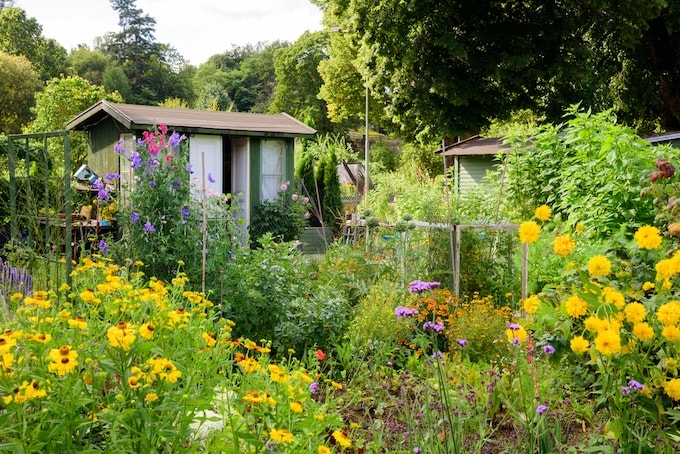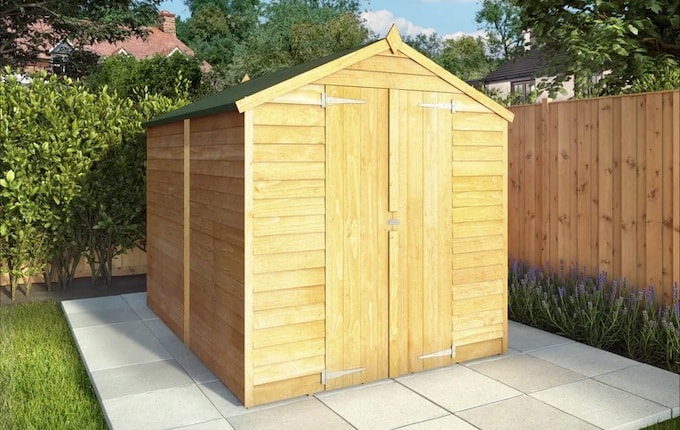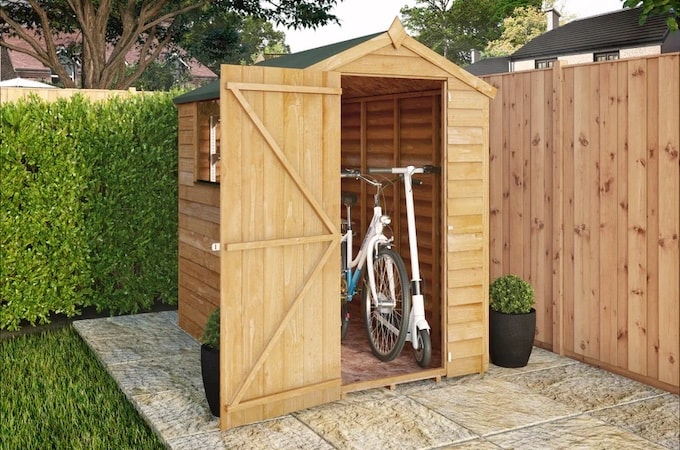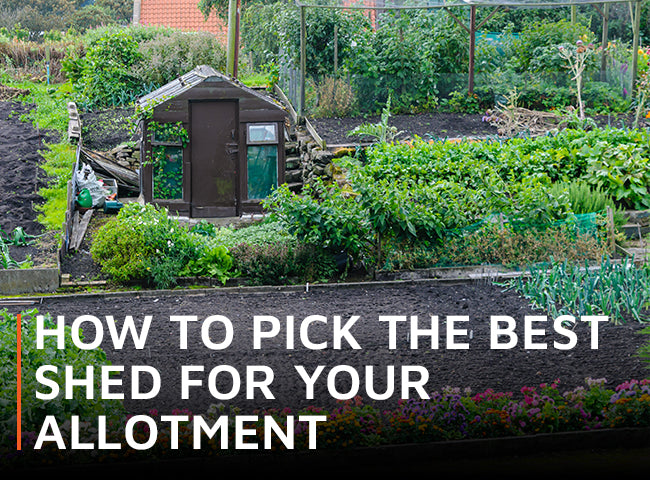A wooden shed is an incredibly useful addition to your allotment. It provides storage, shelter and protection for younger plants. A shed can also provide you with a level of comfort that allows you to garden for longer, when the mood takes you!
But how do you pick the best shed for your allotment? We asked some of our favourite bloggers for their top tips. Here’s what they said…
Do you need a shed on your allotment?

Image: Mikael Broms/Shutterstock
Having a shed is very handy. It gives you somewhere to store your tools and equipment so you don’t have to carry them back and forth from home. It also provides refuge from the British weather - somewhere cosy to sit and enjoy a cup of tea until the rain passes.
Experienced allotmenteers use their shed as a windbreak to create a safe haven for seedlings. If you position a cold frame or mini-greenhouse against the most sheltered side of your shed, your seeds will germinate more quickly.
But for many gardeners, their allotment shed is simply their happy place. As Katie Lane from Orchard Garden Antiques puts it: “My shed is my favourite thing on the allotment and I’d be lost without it.”
Of course, a shed does take up valuable growing room. In the end, you’ll need to decide if you’re happy to sacrifice a few square feet for all the other fantastic benefits.
Which type of shed is best for an allotment?

Image: 8x6ft Overlap Double Door Apex Windowless Shed from Waltons
Traditional wooden sheds look great and are very affordable. They range from basic overlap construction, to sturdier shiplap models. For Adam Leone of Carrot Tops Allotment, the former is good enough: “Essentially I see a shed as a giant tool, so it doesn't have to be too fancy... If I have the choice, I'd opt for a shiplap or a tongue and groove shed as these are a bit sturdier... That said, overlap sheds have served me well and I have no qualms with purchasing one.”
Over at the YouTube channel Cumbrian Homestead, Woody says he prefers shiplap, too, when he can afford the extra cost. But for him, the roof shape is just as important as the construction. His recommendation? “I personally have always opted for 8’ x 6’ apex roofed sheds.”
When it comes to roofs, Greg Holton from @greggrowsuk says that a pent roof is his preferred option, as he likes to “maximise rainfall runoff into my water butts at the rear of the shed.” He does concede, however, that an apex roof might be the better option for taller gardeners, adding, “My first shed was too small for me to stand up in! Have a think about the amount of tools you’ll be storing but don’t forget to leave some space to relax in as well.”
Over at the excellent budget lifestyle blog My Thrifty Life by Cassie Fairy, Cassie’s preferred option is “a potting shed with a glazed section, which would double up as a greenhouse for getting seedlings started.”
And for Matt Peskett from @growlikegrandad, a good allotment shed is one that requires little maintenance and is hard to break into. “Metal sheds don't burn,” he says. “Vandals do like to torch allotment sheds from time to time, [and] a wooden shed is an easy target. A metal shed may cost more, but is more secure and stable in the long run, and doesn't need painting.”
Do you need permission to put a shed on your allotment?

Image: Shutterstock
Before you start shed shopping, check the regulations for your allotment. Many sites require you to get permission before you put up any buildings on your plot. Katie Lane from Orchard Garden Antiques was permitted to install a shed at her allotment, but with certain provisos: “We’re limited to a 6ft by 4ft shed...on our site due to the rules but I think this is a pretty decent size for an allotment shed. As long as you have space to store your tools, take shelter from the rain and brew some tea, that’s all you need!”
Some landlords also have pre-approved positions for your shed that take into account access, shading and boundary maintenance. If your allotment doesn’t have any positioning rules in place, you’re free to site it wherever you like. However, do make sure that you install it on a solid base. As Greg Holton from @greggrowsuk says, “Take time and spend what you need to on a good solid base. My first allotment shed was built on a mix of old broken slabs I found on the plot when I moved in. It was ok, but by the second year, it had started to take on a very wonky look!”
Alexandra Campbell at The Middlesized Garden echoes that advice. She says, “it’s essential to make sure you have a good flat base, made of something like concrete. If you set your shed down on even a slightly uneven surface, it will place the joints under strain. And if wood is in direct contact with the earth, it will rot more quickly.”
And last but not least, your allotment may have rules about maintaining your shed and agreeing to remove it should you decide to give up your plot. Again, check this with your own landlord.
What is the best sized shed for an allotment?

Image: 6 x 4 Overlap Single Door Apex Windowless Wooden Shed from Waltons
Once you know what size shed you’re allowed, decide how you’re going to use it and what your priorities are. Alexandra Campbell from The Middlesized garden says: “The important thing is to work out what you want to do with your shed and what you want to keep in it before choosing the size and style. You may need a larger shed than you think—or you may be able to manage with a much smaller one.”
If you’re new to allotment life and don’t yet know how you might use your shed, Claire Burgess from Claire’s Allotment advises going as big as possible: “Think about what you want to store in your shed [and] always get a shed bigger than your needs at this very moment. You always add more tools as you garden... Also it’s the UK and it can rain at any moment… And when the weather is blazingly hot, you’ll need somewhere to find shade.”
That’s a sentiment with which Kev Alviti at The English Homestead agrees: “I'd say always go for a little bigger than you think you'll need - it'll soon fill up, and you'll be glad of the extra space.”
Your decision will depend on things like distance from home, the size of your plot and the length of time you spend at your allotment. Mike of Flighty’s Plot said: “I only have a small half plot which is less than five minutes away from home so I decided to have a small sentry box type shed. If I had a bigger plot and it was further away from home I would have gone for a small conventional shed. For me a shed is purely a functional, practical, secure place to keep tools that I use regularly.”
Where to position your new allotment shed

Image: 8x6ft Shiplap Potting Shed Wooden Greenhouse from Waltons
It’s worth taking the time to think through the site for your new allotment shed, considering the prevailing wind direction, summer heat, whether or not it might block the light, and a host of other variables. Luckily, we have plenty of advice from our allotmenteers on where best to put your shed.
If, like Woody at Cumbrian Homestead, you live in a part of the country with high winds and heavy rainfall, his advice is very useful. He says, “I live in South Cumbria, which gets high rainfall and strong westerly winds, so for me, it’s important to site the shed with the smaller side facing due west and the door facing due east.”
Woody also adds this advice for securing your shed for the most extreme weather conditions, “If you have an exposed site, then I’d recommend driving in an angle iron close to the shed wall and bolting it through as I’ve seen many sheds blown over by strong winds and gales.”
Given the choice between north and south-facing, Greg Holt from @greggrowsuk says that, although his north-facing door is open to the elements, “north-facing is probably my favourite position as I like my shed to be a cool solace on hot days on the allotment in the summer.”
Another gardener who prefers a north-south orientation for his allotment shed is Kev Alviti of The English Homestead. In his case, however, this is because of the opportunity it presents to train a tree against the south side.
Sally Nex prefers the sunshine of a south-facing shed but says that, although it’s nice to be able to put a table and chair in a sunny spot, the plants have priority as “you want to make the most of whatever growing space you have.” Nick Moyle at Two Thirsty Gardeners is of the same mind, adding that “priority goes to the plants, so our shed is adjacent to the hedge where the unwanted wild plants encroach and the shadows it casts are less likely to block out the sun from our veg plot.”
How to keep an allotment shed secure

Image: Orchard Garden Antiques
“Unfortunately, allotments are often targeted by light-fingered passersby,” writes Nick Moyle at Two Thirsty Gardeners. Because allotments occasionally fall prey to thieves and vandals, he advises that you make sure your shed is “as secure as possible and protected with the toughest locks you can get your hands on.”. Many allotmenteers advise securing your shed with a padlock or D-lock and chaining any equipment inside.
Catherine Hughes from The Growing Family adds, “Because there will be a lot of time when nobody is around at your allotment to keep an eye on things, a good lock and tamper-proof hinges are a must.” Alan of Alan’s Allotment manvslug.uk also advises fitting your shed with hinges that are bolted as well as screwed, but adds that another very valid approach to shed security is to simply “leave it open so they cause no damage”.
Matt Peskett from @growlikegrandad prefers the latter approach: "Don't lock an allotment shed, or store too much of value inside. If you present a padlock it tells would-be thieves that there's something inside worth stealing. Hide tools underneath a compost heap tarpaulin instead."
If thieves are a problem in your area, another approach is to opt for a windowless shed. Woody at Cumbrian Homestead says, “windows are useful but can be a vulnerability as thieves can see what’s inside.”
Shed maintenance tips

Image: Alan's Allotment manvslug.uk
An allotment shed is an investment, and to ensure your new building lasts and lasts, regular maintenance is essential. Here are some tips to help guide you in the right direction.
As well as attending to “painting the timbers, roof repairs, and just generally cleaning inside,” Woody from Cumbrian Homestead recommends laying a weed-suppressing membrane down around the shed curtilages as soon as possible, “otherwise you can waste a lot of time just weeding around your shed!”
Pay attention to your shed roof and repair it as soon as you notice a problem. Catherine Hughes from Growing Family speaks from experience after she inherited a shed with a dodgy roof but put off the repairs: “We thought it would be fine for a year or two, but later discovered that rain combined with wind in a certain direction caused multiple leaks and we were left with very soggy contents. A quick patch-up job would have saved us lots of effort.”
Remember that mice love sheds, writes Substacker Sally Nex. This can be a real problem if you use your shed for storing vegetables during the winter. Her fix is to build mouse-proof mesh cages to hold all her winter stores.
Five must-have features for an allotment shed

Image: Orchard Garden Antiques
Once you’ve got your perfect shed in place, what other accessories do you need to finish it off?
- A water butt is a must, says Kev Alviti from The English Homestead, adding that fitting guttering will make the shed last longer as well.
- Potting bench: Do your back a favour. If you have room in your shed for a potting bench, get one.
- Shelves: Keep your shed tidy and make use of the vertical space. Alan Wooldridge of Alan's Allotment manvslug.uk recommends a high level deep shelf on each sidefor keeping things out of the way.
- Plenty of storage: The holy grail of allotment-shed benefits, think about places to store tools, seeds, pots and compost as well as somewhere to keep fresh produce and dry herbs and flowers.
- Creature comforts: Consider the creature comforts that make your allotment shed a home from home. For Katie Lane,a shed wouldn’t be complete without a stove and a kettle. “You just can’t beat coming back into the warmth of the shed after a weeding session to sip on a nice hot cup of tea whilst admiring all your hard work."
We hope this post has helped you decide which kind of shed will suit you - and your plot. And if you’ve got an extra-special shed on your allotment already, we’d love to see it. Share your photos with us via social media using the hashtag #mywaltons.
|
Contributors list
|



Share:
How to organise your allotment shed
Creating an Efficient Tool Shed